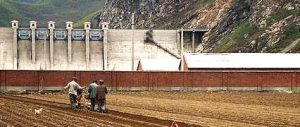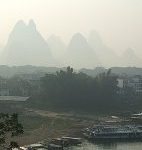Beside a dirt road, farmers shelter from the heat of high noon, carving up watermelons from mountain-high piles – the fruit of the summer harvest in Yongji County, in the south-western corner of China’s Shanxi province. As I sit with the farmers, chomping the fresh fruit, I look out on lush green fields, densely planted with maize and fruit trees, spreading as far as the eye can see. This abundant growth seems to be at odds with the hot and dusty climate and the lack of visible bodies of fresh water. The missing link is the thousands of wells drilled deep into the ground, which, during irrigation season, gush uninterrupted flows of groundwater onto the fields of this abundant agricultural region.
Groundwater is the lifeblood of the farming industry in this area – and in northern China generally – as rivers and lakes are scarce and the climate is relatively arid. In the case of the Yongji farmers, groundwater is drawn from the Yuncheng basin, a 500 metre-thick sequence of sediments holding groundwater of good enough quality for irrigation and, in many cases, drinking. Wells pump the water from a range of depths in the sediments, in some cases from as far down as 350 metres.
An official from the Yuncheng city water bureau told me that farmers living in this basin contribute 60% of total food production in Shanxi, a province with a population of over 30 million. The high rates of agricultural production here are largely supported by the groundwater. However, like any resource, the supply is far from limitless. At current extraction rates, the water in the basin is fast running out and, in many places, rapidly deteriorating in quality.
I travelled to Yuncheng, Linyi and Yongji counties three times between 2007 and 2009 as part of a research project to sample groundwater from the basin for chemical analysis and to find out its age and recharge source, or sources. The results of this study paint a picture of a resource that has great potential to supply water for multiple purposes but is also extremely fragile and – if used unsustainably and without regard for the future – will be lost to the next generation. This is a crucial issue facing farmers throughout northern China, with predictions that groundwater in some regions will run out within 30 years.
Records indicate that groundwater levels in much of the Yuncheng basin have been dropping at a rate of almost three metres per year since 1986; a rate that exceeds the more publicised levels of groundwater drawdown in areas of the North China Plain. Carbon-14 dating and other isotope data from the water indicate that groundwater at levels below 200 metres, where the majority of wells are now drilled, was largely recharged by rainwater between 10,000 and 20,000 years ago. At this time, the climate was cooler than it is today, and rainwater was subject to lower levels of evaporation and transpiration before reaching the water table. The rate of natural recharge by rainfall may be as low as a few millimetres per year and certainly doesn’t come close to the current rates of decline.
Given the long time-scale required to replenish the groundwater and present rates of pumping, this potentially renewable source of water is being mined at a rate that renders it completely non-renewable. The problem may become even more severe as a growing number of scientific reports indicate that rainfall in northern China has been decreasing over the past 50 years, and may continue to do so over the next century.
Another major problem in the Yuncheng basin, and northern China generally, is water quality. Shallow groundwater now receives a large input of irrigation water (sourced from the deep groundwater and, in limited cases, water transported from the Yellow River in canals). This irrigation water floods onto the fields and sits at or just below the surface, where it mixes with chemical fertiliser and is subject to high levels of evaporation and transpiration, causing it to become saline.
Government subsidies allow Chinese farmers to purchase fertiliser at cheap rates and, as a result, they are grossly over-applied to farms in northern China, in an effort to maximise productivity. The excess nitrate that does not get used by the crops infiltrates the shallow soil zone and, ultimately, mixes with the groundwater. In a number of the deep wells that I sampled, high concentrations of nitrate derived from chemical fertiliser were detected in groundwater, in some locations at depths greater than 200 metres. This indicates that 10,000 to 20,000-year-old groundwater is now mixing with water affected by agriculture at the surface, thereby seriously compromising its quality.
Until five years ago, the deep groundwater was also used for drinking in many of the farming villages. A large number of these domestic supply wells have now been abandoned, although they still operate in certain communities. Excessive concentrations of nitrate and salinisation of the groundwater threaten its use both for drinking and irrigation, as crops will only tolerate water below a certain salinity level.
Unfortunately, the groundwater is also being affected by natural enrichment of fluoride and arsenic, both of which are toxic above low concentrations. These elements occur in sediments in many parts of northern China (including the Yuncheng Basin) and are mobilised into groundwater under certain conditions, leading to fluorosis, skin disorders and gastrointestinal problems if the water is consumed for extended periods. High levels of evaporation and transpiration in shallow groundwater can exacerbate this problem in water that already has naturally high fluoride and arsenic concentrations, while high levels of groundwater pumping may also increase mobilisation of these elements.
Overall, the research indicates that, even before the wells dry up and the water runs out, the quality of the declining reserves will be compromised in quality to the point they may not be useable in many areas. The decline of groundwater quantity and quality, due largely to agricultural practices, is one of the most serious environmental issues facing northern China. While the south-north water transfer project and desalination plants may offer some relief to northern China’s water shortage problems decades in the future, the problems described here are immediate concerns that will affect farmers in the coming years.
Educating communities about how groundwater is replenished, the practices that have an impact on groundwater quality – such as fertiliser application and irrigation techniques – and the potential for groundwater that is used sustainably to serve as a long-term renewable resource could all help to avert the looming water crisis facing northern China.
Matt Currell is a PhD student at Monash University, Australia. He conducts scientific research into groundwater quality and sustainability. His research on groundwater in Shanxi has been published by the Journal of Hydrology as Currell, MJ, Cartwright, I, Bradley, DC, Han, DM, 2010. “Recharge history and controls on groundwater quality in the Yuncheng Basin, north China.”
Homepage image from Shanxi Water Resources Department


